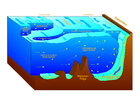- Marine energy
-
Renewable energy Biofuel
Biomass
Geothermal
Hydroelectricity
Solar energy
Tidal power
Wave power
Wind powerMarine energy or marine power (also sometimes referred to as ocean energy or ocean power) refers to the energy carried by ocean waves, tides, salinity, and ocean temperature differences. The movement of water in the world’s oceans creates a vast store of kinetic energy, or energy in motion. This energy can be harnessed to generate electricity to power homes, transport and industries.
The term marine energy encompasses both wave power — power from surface waves, and tidal power — obtained from the kinetic energy of large bodies of moving water. Offshore wind power is not a form of marine energy, as wind power is derived from the wind, even if the wind turbines are placed over water.
The oceans have a tremendous amount of energy and are close to many if not most concentrated populations. Ocean energy has the potential of providing a substantial amount of new renewable energy around the world.[1]
Contents
Potential of ocean energy
The theoretical potential is equivalent to 4-18 million ToE.
Theoretical global ocean energy resource[2] Capacity
(GW)Annual gen.
(TW·h)Form 5,000 50,000 Marine current power[3] 20 2,000 Osmotic power 1,000 10,000 Ocean thermal energy 90 800 Tidal energy 1,000—9,000 8,000—80,000 Wave energy Indonesia as archipelagic country with three quarter of the area is ocean, has 49 GW recognized potential ocean energy and has 727 GW theoritical potential ocean energy.[4]
Forms of ocean energy
Renewable
The oceans represent a vast and largely untapped source of energy in the form of surface waves, fluid flow, salinity gradients, and thermal.
Marine current power
Main article: Marine current powerThe energy obtained from ocean currents
Osmotic power
Main article: Osmotic powerThe energy from salinity gradients.
Ocean thermal energy
Main article: Ocean thermal energyThe power from temperature differences at varying depths.
Tidal power
Main article: Tidal powerThe energy from moving masses of water — a popular form of hydroelectric power generation. Tidal power generation comprises three main forms, namely: tidal stream power, tidal barrage power, and dynamic tidal power.
Wave power
Main article: Wave powerThe power from surface waves.
Non-renewable
Petroleum and natural gas beneath the ocean floor are also sometimes considered a form of ocean energy. An ocean engineer directs all phases of discovering, extracting, and delivering offshore petroleum (via oil tankers and pipelines,) a complex and demanding task. Also centrally important is the development of new methods to protect marine wildlife and coastal regions against the undesirable side effects of offshore oil extraction.
See also
- Energy harvesting
- Hydropower
- Renewable energy commercialization
- SAS Ocean Energy (of Pakistan)
References
- ^ Carbon Trust, Future Marine Energy. Results of the Marine Energy Challenge: Cost competitiveness and growth of wave and tidal stream energy, January 2006
- ^ International Energy Agency, Implementing Agreement on Ocean Energy Systems (IEA-OES), Annual Report 2007
- ^ US Department of the Interior (May 2006). "Ocean Current Energy Potential on the U.S. Outer Continental Shelf" (pdf). http://ocsenergy.anl.gov/documents/docs/OCS_EIS_WhitePaper_Current.pdf. Retrieved 2 November 2010.
- ^ Indonesian Ocean Energy
External links
- European Ocean Energy Association
- Ocean Energy Council
- SuperGen UK Centre for Marine Energy Research
Ocean energy Wave power Australia • New Zealand
Tidal power Osmotic power Other Marine current power • Offshore construction • Ocean thermal energy conversion • Pelamis wave energy converter • • SDE Sea Waves Power Plant • Wind power (offshore) • Wave farmPortals: Energy • Renewable energy • Sustainable development Electricity generation Concepts Availability factor · Baseload · Black start · Capacity factor · Demand factor · Demand management · EROEI · Grid storage · Intermittency · Load following · Nameplate capacity · Peak demand · Repowering · Spark spreadSources Technology Distribution Policies Carbon offset · Coal phase out · Ecotax · Energy subsidies · Feed-in tariff · Net metering · Pigovian tax · Renewable Energy Certificates · Renewable energy payments · Renewable energy policyCategories: Electric power distribution · Electricity economics · Power station technology · Portals: Energy · Sustainable development Categories:- Water power
- Ocean energy
Wikimedia Foundation. 2010.


